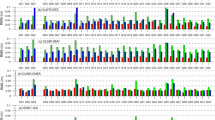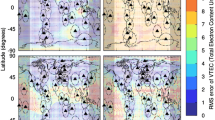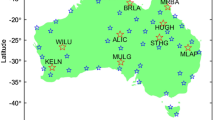Abstract
Real-time single-frequency precise point positioning (RT-SF-PPP) has become a desired positioning approach because it can achieve high positioning accuracy with a low-cost global navigation satellite system (GNSS) chipset or receiver. For single-frequency precise point positioning (SF-PPP) applications, the ionospheric delay is a dominant error source, and thus the quality of applied ionospheric products is critical to the performance of SF-PPP. To meet the demands of the RT-SF-PPP users, the international GNSS service (IGS) is planning to provide open-access real-time ionospheric products. By now, the Centre National d’Études Spatiales (CNES) is the only IGS analysis center (AC) to broadcast real-time ionospheric vertical total electron content (VTEC) message through its real-time service (RTS). The quality of the CNES real-time ionospheric products is drawing increasing attention from the GNSS community. We evaluate the quality of CNES real-time VTEC message both in the ionospheric correction domain and positioning domain. First, 374 consecutive days of CNES VTEC products are collected and compared with the IGS final global ionospheric map (GIM) products. Second, slant total electron content (STEC) computed with CNES VTEC message is fully assessed with respect to STEC derived from dual-frequency GNSS measurements. Finally, RT-SF-PPP is conducted for assessing the quality of CNES real-time ionospheric products in the positioning domain. The degree and order of the spherical harmonic expansions broadcasted in the CNES VTEC messages changed from 6 to 12 in the time span of collected data, the effects of higher degree and order parameters are investigated at the same time in the experiments above.














Similar content being viewed by others
References
Bishop G, Klobuchar J, Doherty P (1985) Multipath effects on the determination of absolute ionospheric time delay from GPS signals. Radio Sci 20(3):388–396
Bisnath S, Gao Y (2009) Current state of precise point positioning and future prospects and limitations. In: Sideris MG (ed) Observing our changing earth, vol 133. Springer, Berlin International Association of Geodesy Symposia
Brunini C, Azpilicueta FJ (2009) Accuracy assessment of the GPS-based slant total electron content. J Geodesy 83(8):773–785
Campbell WH (1996) Geomagnetic storms, the Dst ring-current myth and lognormal distributions. J Atmos Terr Phys 58(10):1171–1187
Choy S (2009) An investigation into the accuracy of single frequency PPP. Dissertation, RMIT University, Australia
Choy S, Bisnath S, Rizos C (2017) Uncovering common misconceptions in GNSS precise point positioning and its future prospect. GPS Solutions 21(1):13–22
de Bakker PF, Tiberius CCJM (2017) Real-time multi-GNSS single-frequency precise point positioning. GPS Solutions 21(4):1791–1803
Feltens J (2003) The activities of the ionosphere working group of the International GPS Service (IGS). GPS Solutions 7(1):41–46
Gao Y, Zhang Y, Chen K (2006) Development of a real-time single-frequency precise point positioning system and test results. In: Proc. ION GNSS 2006, Institute of Navigation, Fort Worth, Texas, USA, Sept. 26–29, pp 2297–2303
Hadas T, Bosy J (2015) IGS RTS precise orbits and clocks verification and quality degradation over time. GPS Solutions 19(1):93–105
Hernández-Pajares M, Juan JM, Sanz J, Qrus R, Garcia-Rigo A, Feltens J, Komjathy A, Schaer SC, Krankowski A (2009) The IGS VTEC maps: a reliable source of ionospheric information since 1998. J Geodesy 83(3–4):263–275
Hernández-Pajares M, Roma-Dollase D, Krankowski A, García-Rigo A, Orús-Pérez R (2017) Methodology and consistency of slant and vertical assessments for ionospheric electron content models. J Geodesy 91(12):1405–1414
Holmes SA, Featherstone WE (2002) A unified approach to the Clenshaw summation and the recursive computation of very high degree and order normalised associated Legendre functions. J Geodesy 76(5):279–299
Kazmierski K, Sośnica K, Hadas T (2018) Quality assessment of multi-GNSS orbits and clocks for real-time precise point positioning. GPS Solutions 22:11. https://doi.org/10.1007/s10291-017-0678-6
Nie Z, Gao Y, Wang Z, Ji S, Yang H (2018) An approach to GPS clock prediction for real-time PPP during outages of RTS stream. GPS Solutions 22:14. https://doi.org/10.1007/s10291-017-0681-y
Roma D, Hernandez M, Garcia-Rigo A, Laurichesse D, Schmidt M, Erdogan E, Yuan Y, Li Z, Gómez-Cama JM, Krankowski A (2016) Real time global ionospheric maps: a low latency alternative to traditional GIMs. 19th International Beacon Satellite Symposium (BSS 2016), Trieste, Italy, 27 June–1 July, p 1
RTCM Special Committee (2014) Proposal of new RTCM SSR Messages, SSR Stage 2: Vertical TEC (VTEC) for RTCM Standard 10403.2 Differential GNSS (Global Navigation Satellite Systems) Services-Version 3. RTCM Special Committee No. 104, USA
RTCM Special Committee (2016) RTCM Standard 10403.3 differential GNSS (Global Navigation Satellite Systems) Services-Version 3. RTCM Special Committee No. 104, Arlington, TX, USA
Schaer S (1999) Mapping and predicting the Earth’s ionosphere using the Global Positioning System. Dissertation, University of Berne, Switzerland
Shi C, Gu S, Lou Y, Ge M (2012) An improved approach to model ionospheric delays for single-frequency precise point positioning. Adv Space Res 49(12):1698–1708
Teunissen P, Khodabandeh A (2015) Review and principles of PPP-RTK methods. J Geodesy 89(3):217–240
van Bree RJ, Tiberius CC (2012) Real-time single-frequency precise point positioning: accuracy assessment. GPS Solutions 16(2):259–266
Wang L, Li Z, Ge M, Neitzel F, Wang Z, Yuan H (2018) Validation and assessment of multi-gnss real-time precise point positioning in simulated kinematic mode using IGS real-time service. Remote Sens 10(2):337
Weber G, Mervart L, Lukes Z, Rocken C, Dousa J (2007) Real-time clock and orbit corrections for improved point positioning via NTRIP. Proc. ION GNSS 2007, Institute of Navigation, Fort Worth, TX, USA, Sept 25–28, 1992–1998
Zumberge J, Heflin M, Jefferson D, Watkins M, Webb FH (1997) Precise point positioning for the efficient and robust analysis of GPS data from large networks. J Geophys Res Solid Earth 102(B3):5005–5017
Acknowledgements
This study was supported by Key Program of National Natural Science Foundation of China (Grant No.: 41631073), National Natural Science Foundation of China (Grant No.: 41604027) and Qingdao National Laboratory for Marine Science and Technology (Grant No.: QNLM2016ORP0401). The authors acknowledge Denis Laurichesse from CNES for valuable discussions. CNES and IGS are thanked for providing the experiment data. In addition, the anonymous reviewers are greatly thanked for their remarks and suggestions.




